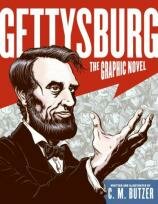Gettysburg: The Graphic Novel
Review
Gettysburg: The Graphic Novel
About halfway through Gettysburg, a photographer arrives to record the aftermath of the battle. “Such a picture conveys a useful moral,” he muses, as he focuses on a body lying on the battlefield. “It shows the blank horror and reality of war, in opposition to its pageantry.”
The same could be said of Gettysburg: The Graphic Novel. War is often spoken of in terms of great masses of soldiers advancing, retreating, or flanking the enemy. C. M. Butzer brings the battle down to the atomic level, showing individual soldiers fighting in the woods, charging with bayonets drawn, and staring up, dumbstruck, as a cannonball hurtles down upon them from the sky. And he does not flinch from the horrors of war; after the battle, he shows bodies scattered on the battlefield and a soldier nonchalantly carrying an armload of amputated arms and legs.
In just 80 pages, Butzer sets the scene, depicts the battle and its aftermath, and shows the movement to create a national cemetery on the site, as well as Lincoln writing his speech and the ceremony at Gettysburg.
This is a lot of material, and the first half of the book is too compressed. The initial skirmish at Gettysburg is over with in three pages, and the action is hard to follow. The generals speak in sound bites and then disappear. We catch a brief glimpse of a field hospital, a short exchange with the governor of Pennsylvania, a snatch of conversation among the cemetery planners. Butzer compensates for this with copious notes in the back of the book, in which he fully explains each scene and adds more historical details. This makes interesting reading, but it would have been even better if it had been integrated more fully into the narrative.
While this part of the book is hard to read, it also succeeds in doing something only a graphic novel could do: It puts the reader inside the story. It’s one thing to read an account of a battle, but quite another to look down the dusty streets of Gettysburg and see the Confederate troops advancing while the local African Americans move out to safer territory.
Once Lincoln appears, about halfway through the book, the action slows. We see Lincoln riding the train to Gettysburg and meditating in silence in his hotel room. Then we get to see a rare sight: The delivery of the Gettysburg Address in its original context, at the battlefield, and preceded by a long, fiery speech by the famous orator Edward Everett. When Lincoln takes the stage, the stillness is palpable. As Lincoln delivers the speech, Butzer backs away from literal reality, illustrating the words with depictions of the full pageantry of American civil rights history, from the Revolution and the founding fathers to union marches, suffragists, and a gay liberation parade.
Butzer’s figures sometimes look stiff and awkward, but he is very good at setting the scene and conveying emotion. And that’s the real value of Gettysburg: it does more than just present the facts, it puts the reader in the heart of the story, providing a rare look at history from the inside out.
Reviewed by Brigid Alverson on December 23, 2008
Gettysburg: The Graphic Novel
- Publication Date: December 23, 2008
- Genres: Graphic Novel
- Hardcover: 80 pages
- Publisher: HarperCollins
- ISBN-10: 0061561762
- ISBN-13: 9780061561764









